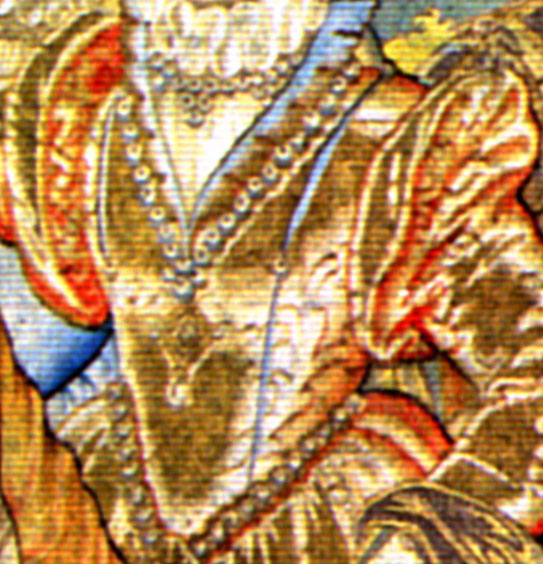

Virgin and Child, Valois
Tapestry
Women's Garment Myths
Myth: Here is proof of a "princess seam" in medieval/renaissance portraits.
The best answer to these two images comes from Robin Netherton, a noted medieval clothing researcher. This is the most recent of her comments on the subject over the years.
This (image on left) is the earliest depiction I know for over-the-bust seams in western Europe. It is frequently cited for that purpose; quite often people point to it and say, as you essentially did above, "Look, a princess seam! I thought those weren't period! Here's proof they are!"
I try to avoid the term "princess seam" for a medieval or renaissance over-the-bust seam, because the modern princess seam serves a different function -- it was designed to gently shape a dress over a body whose shape is already manipulated by foundation garments. The medieval and renaissance over-the-bust seams appear to be part of a shaping of a gown that will itself manipulate the body. Also, these seams come in a variety of placements and degrees of curve, with different effects, so it seems wise to avoid the assumption that they all are placed and shaped like modern princess seams.
Some people try to make some sort of distinction between over-the-bust seams that go into the shoulder seam vs. those that go into the armhole seam, but I have not found this a useful distinction myself.
In short: Although princess seams go over the bust, not all over-the-bust seams are princess seams. There are a variety of medieval and renaissance cuts that clearly use over-the-bust seams, but I know of none that act like a modern princess seam. If you use a modern pattern that has princess seams, you will almost certainly need to wear modern underpinnings, and the effect will be modern.
-- Robin Netherton, Re: [h-cost] princess seams in middle ages? Historical Costume mailing list, Sun, 31 Dec 2006.
I prefer to call them fitting seams, because they are created when fitting a garment close to the body. Sometimes they are needed, but it is based on fitting to the individual body.
Detail of Virgin and Child Surrounded by Angels, by Jean Fouquet, c. 1450. Koninklijk Museum voor Schone Kunsten, Antwerp. Retrieved January 22, 2007 from the World Wide Web: http://www.wga.hu/html/f/fouquet/madonna.html
Detail from the Valois Tapestry, taken from Splendor at Court by Roy Strong, ISBN 0394172209, pg 147.